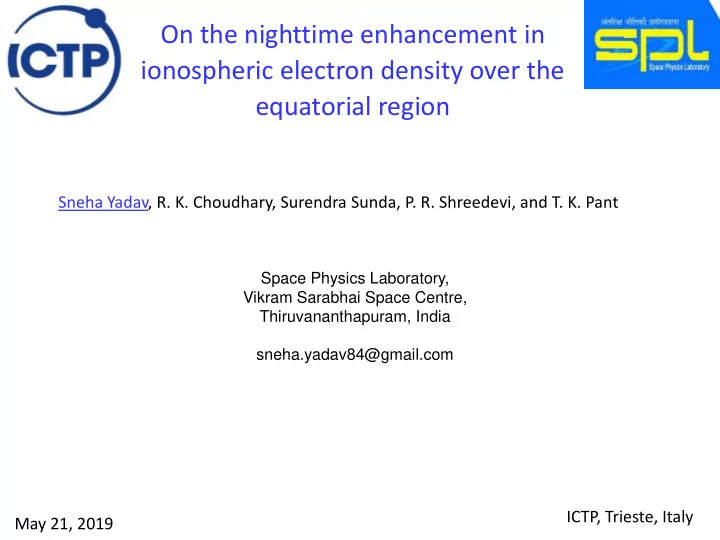

On the nighttime enhancement in ionospheric electron density over the equatorial region Sneha Yadav, R. K. Choudhary, Surendra Sunda, P. R. Shreedevi, and T. K. Pant Space Physics Laboratory, Vikram Sarabhai Space Centre, Thiruvananthapuram, India sneha.yadav84@gmail.com ICTP, Trieste, Italy May 21, 2019
Ionospheric Nighttime Enhancement (INE) “At nighttime, during the absence of ionization, the ionospheric electron density is generally expected to decay gradually but it does not behave as predicted by the simple notion and show enhancement occasionally”. This phenomenon is called ionospheric nighttime enhancement (INE). • Based on the time of occurrence, INEs have been classified into two types: Premidnight and Postmidnight • According to the geographic region, they can be categorized as: Mid-latitude, Low-latitude and Equatorial INEs • The underlying physical mechanism proposed for different INE events are also different. • The studies regarding INEs over the equatorial region are rather sparse.
Equatorial and Low-Latitude Ionosphere The unique configuration of Irregularities geomagnetic field lines over the Geomagnetic geomagnetic equator forms the base Field lines for the various plasma processes. - Equatorial Electrojet (EEJ), Ionization - Equatorial Ionization Anomaly crest (EIA) EIA - Equatorial Spread- F (ESF) Ionization trough
Equatorial Ionization Anomaly Fountain effect: During the daytime, the eastward zonal electric field in conjunction with the horizontal N-S component of the geomagnetic field gives rise to the vertical E × B drift over the geomagnetic equator which in turn lifts the plasma to higher altitudes. Reverse Fountain Effect: Consequence of the change in the direction of the Basu et al., 2002 zonal electric field from eastward to westward and characterized by the movement of the EIA crest towards the equator. Watthanasangmechai et al., 2013
GPS Aided Geo Augmented Navigation (GAGAN) INDIAN SBAS • There are 15 reference stations under SBAS-GAGAN. • A unique iono model was developed for GAGAN to broadcast the vertical delay (GIVD) at IGPs. • GAGAN is broadcasting the ionospheric corrections over 102 (IGP) ionospheric grid points (5 ° Lat x 5 ° Long) through Geostationary satellites. A very simplistic and novel approach as suggested by Sunda et al., [2015] has been used to generate the spatio- temporal TEC maps over the Indian region using GAGAN.
GAGAN generated 2D-TEC Maps 16 March 2015 Quiet Day 17 March 2015 Geomagnetic storm day 18 March 2015 Recovery day Yadav et al., 2016
Dataset Indian Space Weather Ionospheric Monitoring stations GPS measurements Trivandrum (8.5 ° N, 77.1 ° E, 0.5 ° N) Bengaluru (12.9 ° N, 77.6 ° E, 4.1 ° N) Ionosonde measurements over Trivandrum: foF2: F2 region critical frequency h’F : F-region base height hmF2: peak electron density height of the F2 region Vz: Vertical drift Satellite Based Augmentation System (SBAS): To study the motion of EIA Case Study Based on the common availability of the dataset
Typical Examples of INE Trivandrum (8.5 ° N, 77.1 ° E, 0.5 ° N) Bangalore (12.9 ° N, 77.6 ° E, 4.1 ° N)
Night-time Enhancement Event Identification • The preceding minimum of electron densities after sunset has been chosen as the reference to quantify the nighttime enhancement. • The TEC values are subtracted from this reference level.
Typical Examples of INE
CASE1: 01 Feb 2014 • The two humps in the Δ TEC values over both the station is well discernible from the figure. • The enhancement in the postmidnight Δ TEC values appears first over Bangalore and then over Trivandrum. • The vertical drift remains westward from ~16 to 19 UT with a maximum value of -25m/s.
CASE1: 01 Feb 2014 SBAS 2D-TEC Maps Motion of EIA during Night-time over the Indian longitudes
CASE2: 21 Feb 2014
CASE3: 06 Feb 2014
CASE5: 20 Feb 2014
Mechanism responsible for INE Night-time Equatorial ionosphere Westward electric Equatorward field Meridional wind Transport higher- Downward E × B density plasma drift towards equator Reverse plasma fountain Increase in electron density over equator
Summary • The GAGAN (Indian SBAS) generated maps are effective in studying in the reverse fountain effect. • Results enable visualizing the association of mid-night enhancement in the electron density over the equatorial region with the reverse fountain effect. • Results suggests that the combined effect of downward E × B plasma drift due to westward electric field and equatorward meridional at night are the main driving force for the nighttime enhancement over equatorial regions. Thank You !
Recommend
More recommend